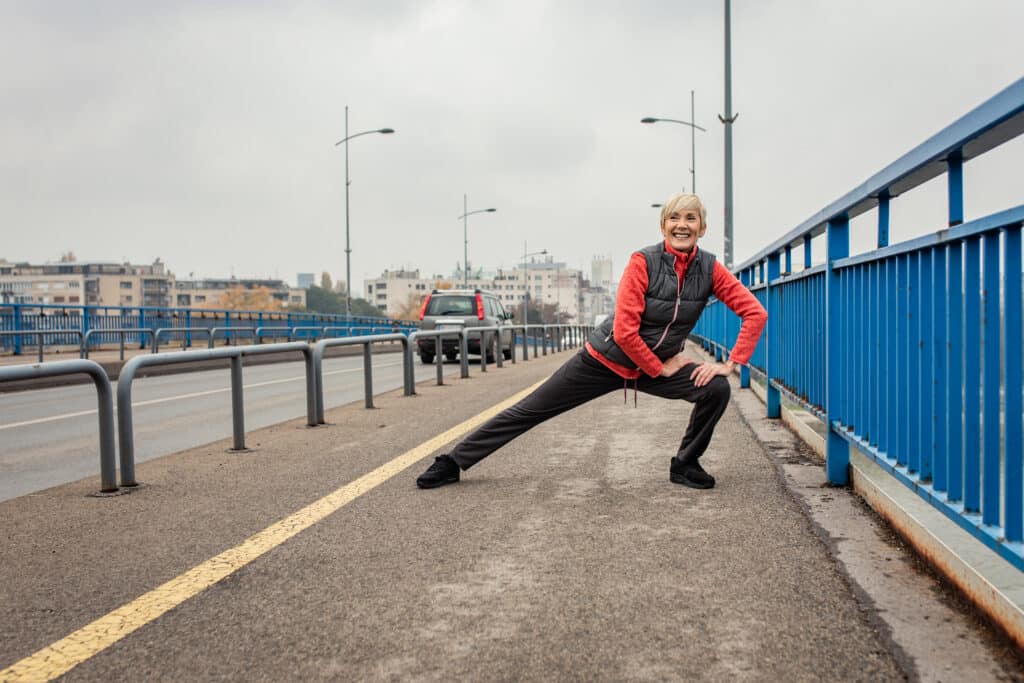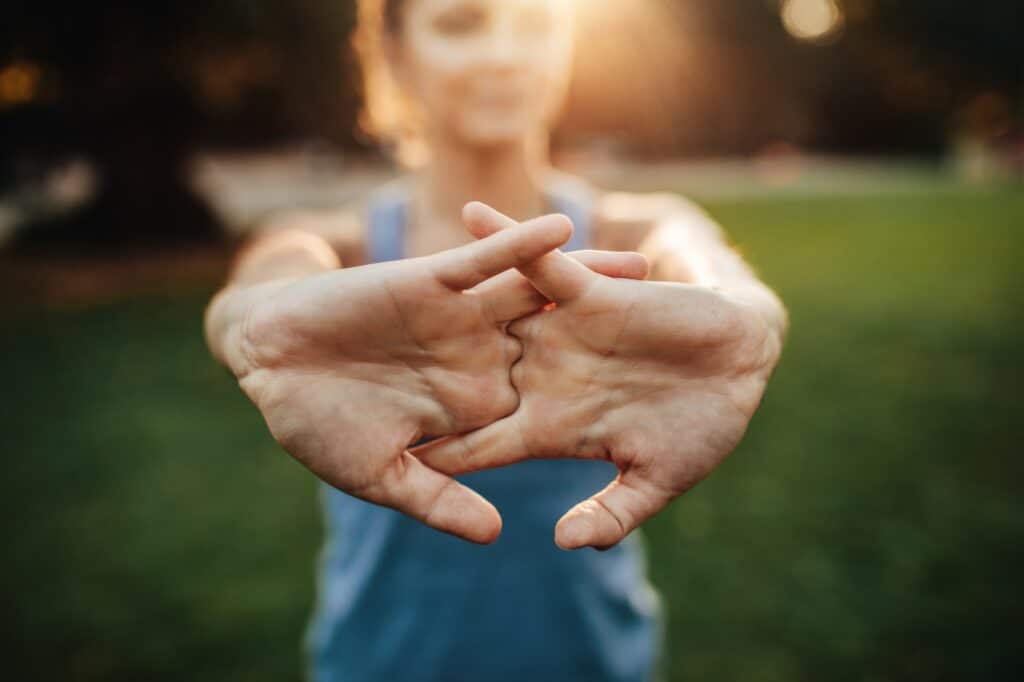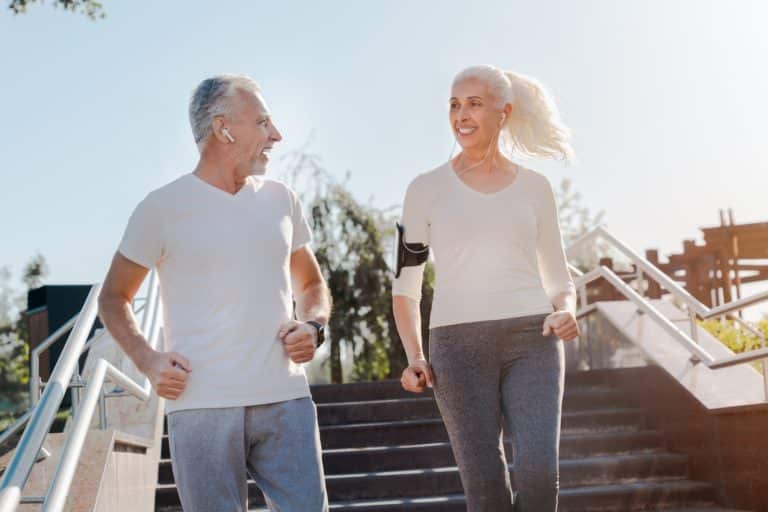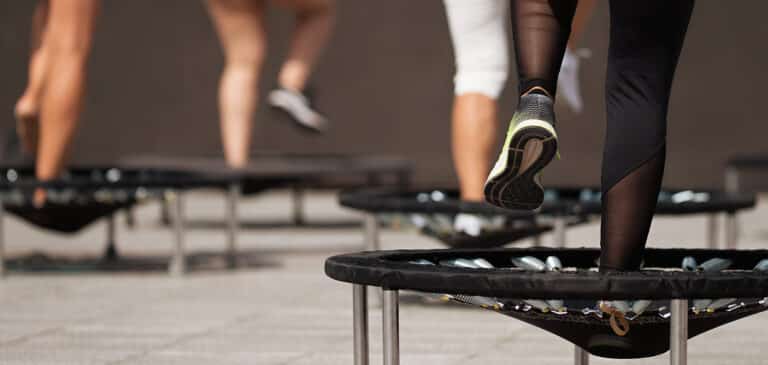Staying active is vital at any age, but as we get older, how we prepare for physical activity becomes increasingly important. An exercise warmup for seniors can make a huge difference in staying strong, healthy, and injury-free.
Warm-ups elevate the core body temperature and prepare the heart, muscles, and joints for the demands of physical exertion. This is particularly crucial in cooler temperatures, where the risk of heart strain increases.
This article focuses on the significance and methodology of an optimal exercise warm-up for seniors, a crucial step in maintaining a healthy and active lifestyle. We’ll explore the benefits of warm-ups, the difference between dynamic and static stretching, and provide specific warm-up exercises tailored for seniors.
These exercises increase flexibility, prevent injuries, and enhance overall exercise performance. Remember, a proper warm-up is not just a preliminary step; it’s an essential part of your fitness routine that prepares you for the day’s activities and helps prevent injury.
What is a Warm-up?

Simply put, a warm-up elevates core body temperature to prepare your heart, muscles, and joints for exercise.
Warming up your lower body, upper body (or both) can significantly increase flexibility and prevent exercise-related injury. Perhaps most importantly, in temperatures below 59º, the arteries may have a more limited capacity to transport blood, which can lead to unnecessary strain on the heart.1
Ideally, a short warm-up provides the necessary preparation your body needs to exercise safely.
Let’s examine the specifics of a warm-up and why it’s key to your exercise health practice.
The Benefits of Warming Up
The heat you feel when you walk up a steep hill indicates a boost in core body temperature. This is a sign that your heart is working to pump blood into your muscles.
Skipping the warm-up means running a higher risk of injury. Without some form of warmup exercise, the muscles and connective tissue (including the muscle in your heart) are not ready to move, especially if you are new to exercise.
Starting your day, or your exercise session, with some vigorous movement similar to the movements you are about to partake in can help keep you safe.2
Is a Warm-Up the Same as Stretching?
Yes and no. Typically, we think of stretching exercises as a ‘stretch-and-hold’ (or static stretching) approach. While static stretching is an excellent idea after your workout, the primary goal for a warm-up is to move in ways that resemble the activity in which you are about to participate.
These are known as dynamic stretches– or dynamic warm-ups. Dynamic stretches can be considered a less intense but similar activity to the one you’re preparing for, typically with a smaller range of motion.
Since many physical activities require the use of all or most parts of the body in some way, it’s best to utilize warm-ups that include your whole body and some movement of the spine to ensure that all body parts are properly prepared.
Carefully chosen dynamic warm-up exercises also offer safe and simple challenges to your balance, which further benefit fall prevention for general health.3
By preparing the muscles for activity, switching on your body’s ability to balance, and elevating your heart rate to get the blood flowing, warm-up exercises provide a simple and effective way to make injury prevention a centerpiece of your fitness routine.
The Best Exercise Warmup for Seniors
Let’s begin with simple exercises to get your body moving and your heart rate elevated!
High Knees
- Stand upright with your shoulders back and feet shoulder-width distance apart.
- Hold your hands in front of you at about belly-button height and begin to march, eventually bringing each knee up to touch your palm.
- Make this a brisk but controlled movement. With each step, you should feel a slight balance challenge in the standing leg.
- Do 20-30 marches or more if you’re feeling good. You can also include a few ankle circles with the lifted leg for an extra coordination challenge.
Shoulder Rolls
- Let your arms hang at your sides with your feet shoulder width.
- Shrug your shoulders up toward your ears and then back down as if you’re trying to reach your shoulder blades toward your back pockets.
- Repeat this motion 8-10 times in each direction.
Bent-Arm Shoulder Rotations
- Extend your arms out to the sides, just below shoulder height.
- Now, bend your elbows as if trying to put your fingertips on your shoulders.
- Begin making small circles in the air with the tips of your bent elbows.
- Do 12-15 repetitions in each direction.
Arm Swings
- In the same starting position, anchor your feet on the ground and turn your torso to the right.
- Let your arms remain loose so that they swing across and around your body, then turn to the other side and let your arms follow.
- This classic dynamic warm-up stretches the arms and shoulders while creating a gentle warm-up twist for the spine.
Cardio Warm-Up
Now that we’ve gotten the blood flowing, we’d encourage you to walk around the block briskly to stimulate more blood flow. At this point, your warm-up should feel like a small workout.
Once again, one of our main priorities is getting the heart to work a little harder.
Consider using the “talk test”: walk at a pace where you can still say two sentences without running out of breath. For a warm-up, pushing yourself any harder than this is not necessary.
Warm-Up Strength Exercises
Finally, we’ll finish our sequence with a round of squats and rotating lunges to bring a little bit more heat to our warm-up.
Lunges
- With one hand on a chair or other surface for support, take a big step forward with your right leg.
- Bend your knees slightly for a shallow lunge. While you should feel your legs working, touching your back knee to the ground is unnecessary.
- Carefully step back to the starting position. Switch legs and repeat on the left side.
- Do 6-8 reps on each side.
Squats
- Stand tall with feet shoulder width.
- Bend at the knees and waist as if you’re about to sit down on a high stool. Be sure to keep your chest upright.
- Return to the starting position and repeat 8-10 times.
Taking the time to allow your body’s muscles to prepare for exercise can mean the difference between feeling great and being unnecessarily injured.
A good warm-up is a short workout to prepare you for your longer one. Through a simple practice of careful movement and dynamic stretches, you can prepare for any activity
We hope that this short routine can help you prepare for any of your favorite exercises and activities, and as always, consult with your doctor before beginning any new exercise program
Key Takeaways
- A warm-up elevates core body temperature and prepares the heart, muscles, and joints for exercise. This is especially important in cooler temperatures to prevent heart strain.
- Warm-ups increase flexibility, prevent injuries, and prepare the muscles and heart for activity.
- Warm-ups should consist of dynamic stretches that mimic the upcoming activity, not static stretches, which are more suited for post-exercise.
- Effective warm-ups engage the whole body and spine, offering balance challenges for fall prevention.
- Specific senior-friendly exercises include high knees, shoulder rolls and rotations, arm swings, brisk walking, and strength exercises like lunges and squats.
- A proper warm-up is crucial for more intense exercise and should always be conducted after consulting with a doctor.
FAQs
How long should a warm-up last for seniors?
Typically, a warm-up should last about 5-10 minutes, providing enough time to gradually increase your heart rate and prepare your muscles and joints for more strenuous activity.
What are the signs of an effective warm-up?
An effective warm-up will make you feel slightly warmer, with a mild increase in heart rate and a gentle sweat. Your muscles should feel loose and ready for exercise.
Can warm-ups help manage chronic conditions like arthritis?
Absolutely. Regular warm-ups can help reduce stiffness and improve mobility, making it easier to manage arthritis and engage in daily activities comfortably.
Are there specific warm-up exercises to avoid for seniors?
Seniors should be wary of high-impact exercises like jumping jacks or fast-paced running during warm-ups. These can be too strenuous and increase the risk of injury.
How can warm-ups be adapted for seniors with limited mobility?
Warm-ups can be easily adapted by performing seated or supported exercises. Gentle, controlled movements that increase blood flow and flexibility without overexertion are ideal.
What role does breathing play in a warm-up routine?
Proper breathing during warm-ups enhances oxygen delivery to your muscles, improves circulation, and helps maintain focus and calmness, all of which are essential for effective exercise.
Can a warm-up improve balance and coordination?
Yes, incorporating dynamic exercises that challenge your balance and coordination can improve these skills over time, reducing the risk of falls and enhancing overall stability.
What are some common mistakes seniors make during warm-ups?
Common mistakes include skipping the warm-up entirely, performing static stretches instead of dynamic ones before exercise, and not gradually increasing the intensity.
How can technology aid in warm-ups for seniors?
Wearable fitness trackers can help monitor your heart rate to ensure a safe and effective warm-up intensity. Fitness apps also provide guided routines tailored to your needs, making warm-ups easier and more efficient.
References
- https://www.health.harvard.edu/staying-healthy/an-older-adults-guide-to-exercising-in-cold-weather. https://www.health.harvard.edu/staying-healthy/an-older-adults-guide-to-exercising-in-cold-weather
- McCrary, J. M., Ackermann, B. J., & Halaki, M. (2015). A systematic review of the effects of upper body warm-up on performance and injury. British journal of sports medicine, 49(14), 935-942. https://bjsm.bmj.com/content/49/14/935?legid=bjsports;49/14/935
- Thomas, E., Battaglia, G., Patti, A., Brusa, J., Leonardi, V., Palma, A., & Bellafiore, M. (2019). Physical activity programs for balance and fall prevention in elderly: A systematic review. Medicine, 98(27). https://www.ncbi.nlm.nih.gov/pmc/articles/PMC6635278/






